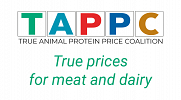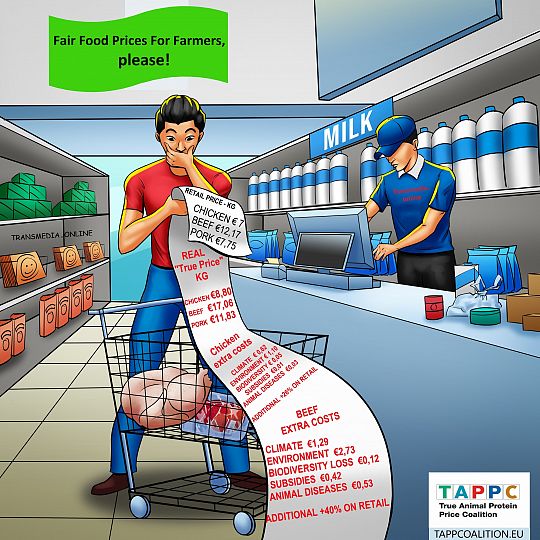EU Policy Proposals
Towards new EU policies promoting CO2-eq. reduction in food products
Here you can find the TAPP Coalition policy proposals for the the EU Commission and EU Member States, related to the European Green Deal and the Farm to Fork Strategy and the EU position towards the COP26 (Glasgow) and CBD (China):
In addition to the recommendations mentioned in the TAPP Coalition report above, we propose different EU policies for food, contributing to the Paris Climate Agreement. Without such policies, 81% of the total carbon budget in 2050 will be consumed by food related greenhouse gasses from meat and dairy. Climate - food policies will help governments worldwide to contribute to their commitments of the Paris Climate Agreement for 1,5-2 degrees Celsius.
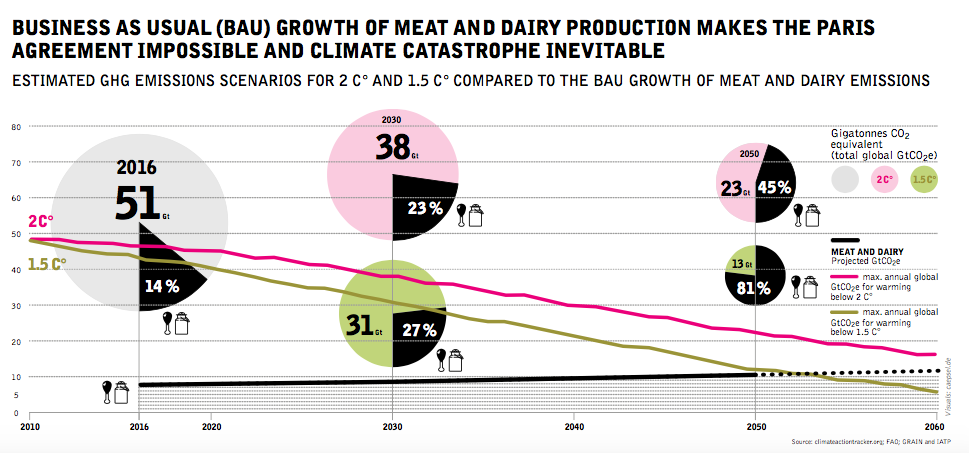
1) EU Directive on the Promotion of the use of plant based proteins in food (‘New minced meat directive’).
2) EU Directive for the Reduction of food related greenhouse gas emissions (“Supermarket directive”).
3) EU facilitation EU member states to introduce true pricing mechanisms for animal protein products (including CO2eq taxes)
4) EU Directive on agriculture based methane and nitrous oxide (non-CO2 greenhouse gasses into the EU Emission Trading System ETS or a separate reduction scheme).
5) Reducing EU subsidies for food products with the 50% highest climate footprint.
6) A global system for reducing greenhouse gas emissions from meat and dairy sectors (define an emission cap, with climate neutral growth in 2021-2025 and 1-2% reduction per year of emissions in 2025-2050.
Below, we will describe the six different options.
1) EU Directive on the Promotion of the use of plant based proteins in food (‘New minced meat directive’).
Comparable to the Directive on the Promotion of the use of biofuels and other renewable fuels for transport, officially 2003/30/EC and popularly better known as the biofuels directive for promoting the use of biofuels for EU transport, and to contribute to the EU targets in 2030/2050 made at the Paris Climate Agreement (1,5-2 degrees C. goal), it is time to consider a new EU Directive for the Promotion of the use of plant based proteins in food. This new Directive can lead to a reduction of 5% of (global) greenhouse gas emissions related to meat consumption in the EU. EU meat consumption causes ca. 30% of all food related greenhouse gasses and ca. 5% of EU greenhouse gas emissions[1]. A new EU directive can reduce 0,25% of EU greenhouse gas emissions (0.25 x 4466 million ton CO2eq = 11,16 million ton CO2eq). In the Netherlands, in 2012 a report was written by CE Delft[2]where this policy option was described and calculated. It is possible to replace part of the meat with vegetable proteins in all kinds of mixed meat products. In many supermarkets (e.g. supermarket leaders Albert Heijn and Jumbo in the Netherlands), this option is already being applied, with the claim that such products are less fat and healthier. The blending of vegetable ingredients is an interesting option to reduce EU meat consumption without consumers having to change their behavior and without meat taxation. Meatless is an example of a 100% vegetable product, a good fat substitute in meat products and is made from lupine, wheat, white beans, seaweed or rice. Meatless is successfully applied in sausages, snacks, chicken products, minced meat, hamburgers, ready meals, pâté, nuggets, etc. in European top (meat) brands, but there are many other plant based meat alternatives fit for blending with meat products, with comparable environmental impacts[3].
In various products on the Dutch market Meatless is already 'mixed in', up to 20% of the weight of the meat product (Meatless, 2012)[4]. Mixing is possible in minced meat and products that already consist of several types of meat (e.g. sausages). In 2010, 19% of household consumption of meat in the Netherlands consisted of minced meat, and 11% of mixed meat products (PVE, 2010). Similar numbers will apply for the EU. This means a new EU directive will have an effect on 30% of all meat sold in the EU. In the calculation, it is assumed that the products are proportionally composed of beef, pork and chicken. Replacing 20% of the meat in minced meat and the mixed meat products by – for example - Meatless (a plant based protein) provides a climate change gain of 4,8% (0,8 Mton CO2 eq reduction) compared to current meat consumption in the Netherlands (16,6 Mton CO2 eq emission, source: CE Delft, 2012). A replacement of 20% of the meat in minced meat and in mixed meat products results in a replacement of 5.5% of the total meat consumption. If only minced meat is used for blending with Meatless, this already results in a 3% reduction in meat consumption. Meatless plant based products can also be mixed in, for example, hamburgers, and maximum blending percentages may be higher. That is why it is conceivable that a percentage of 5% replacement of total meat consumption is feasible. With this option, a compulsory percentage of 5% replacement of all meat can therefore be justified.
Comparable to the biofuels directive, a new directive to promote plant based proteins in meat, entering into force in 2021, could stipulates that national measures must be taken by countries across the EU aiming at replacing 5% of all meat, sold to consumers. Therefore, all minced meat and composed meat products will have to be blended with plant based proteins with 20% in 2025, starting with 5% in 2021 and 10% in 2023. Member states are encouraged to take on national "indicative" targets in conformity with the overall target.
2) EU Directive for the Reduction of food related greenhouse gas emissions (“Supermarket directive”)
The agriculture and food sector are not included in the EU Emission Trading System (non-ETS sector). EU member states have to develop their own policies to reduce greenhouse gas emissions in this sector. However, some guidance by the EU Commission is possible, by proposing a new EU Directive for supermarkets and retailcompanies, selling food to consumers. Comparable to the ETS sector, those companies can be made responsible to reduce the greenhouse gas emissions of the foodproducts sold by them, in the same way ETS sectors have to do this (annual decrease of 2,2% of CO2-eq. emissions from 2021-2030[5]). Food sales are responsible for ca. 15-20% of all greenhouse gasses in the EU (depending if food related emissions outside the EU are counted in or not). The new EU directive for supermarkets ensures the greenhouse gasses by food consumption in the EU are reduced by 20% in 10 years time (2,2% annual decrease). To realise this goal, supermarkets can choose four options:
1) Gradually increase the market share of food products with a relative low climate footprint (e.g. sell more plantbased meat alternatives and reduce selling bovine meat, which has the highest climate footprint per kg meat);
2) Demand food industry and farmers to reduce the climate footprint of their products;
3) Sell (more) climate neutral food products;
4) Compensate the greenhouse gas emissions caused by selling food products (making food climate neutral, standardized and EU recognized and ngo approved compensation methods).
The EU Directive will be applicable for the large retail supermarkets and other food retail shops, but to limit administrative burden for small retail shops, the directive is excluded for them (e.g. for shops with an annual turnover lower than 20.000 euro; selling less than 64 euro’s per day on average).
3) EU facilitation EU member states to introduce true pricing mechanisms for animal protein products (including CO2eq taxes)
EU member states have the authority to introduce CO2 or environmental taxes, including food products with a high CO2 eq. footprint per kg. In 2012 for instance, Denmark had a tax on meat (based on fat content). In The Netherlands, the Ministry of Finance now is studying a 'fair price for meat' for the renewal of the tax system. This new consumer tax, brings in 1 billion euro per year. The proposal is, this will be used for a 'Fair Food Price Fund' to pay farmers for additional measures (climate, environment, animal welfare, nature) and to compensate households with low incomes, to make sure eating meat is not only for the rich. The Fund also contains enough money to reduce VAT tariffs towards the EU minimum of 5% on vegetables, fruits, potatoes and meat alternatives. In addition, part of the "Fair Food Tax' revenues can be used for funding the UN Green Climate Fund for mitigation and adaptation. UN countries promised to contribute to this global fund (for poor countries, suffering from the effects of climate change, caused by 80 percent by rich (G20) countries). Only a fraction of the promised donations are committed and paid.
In The Netherlands, a majority of the population supports this package for green food pricing (52 up to 63 percent of the population). The TAPP Coalition will present this proposal (and other proposals) at EU level the 5th of February 2020 during a conference in Brussels in the European Parliament Building (8-10 h). The conference is hosted by the Greens (Bas Eickhout). Questions and reservations: info@tappcoalition.eu.
4) EU Directive on agriculture based methane and nitrous oxide (non-CO2 greenhouse gasses into the EU Emission Trading System ETS or a separate reduction scheme).
In the EU-27, 49% of all methane emissions are produced by the EU livestock sector and 78% of all nitrous oxide (N2O) is emitted by the agricultural sector, including emissions from feed produced only on EU soil. Based on standard IPCC methodology, the European Environment Agency (EEA) reports that the EU27 agricultural sector is responsible for 9.8% of total EU GHG emissions[6].
An EU Directive on agriculture based methane and nitrous oxide (non-CO2greenhouse gasses) can guarantee that those gasses will have to be reduced in 2030, 2040 and 2050 with specified targets, comparable with (but lower than) the reduction of CO2-emissions. It has to be determined, the EU Directive will lead to inclusion of the non-CO2 greenhouse gasses by agriculture into the EU Emission Trading System ETS, or that a separate reduction scheme for the non-CO2 greenhouse gasses from agricultural sources has to be developed. In both cases, for administrative reasons, it is preferred, that the food industry will be responsible for the reduction of emissions to be applied at farm-level, as there are millions of farmers and (only) thousands of European food companies (dairy- and meat- companies, slaughterhouses etc.). Dairy- and meat companies can decide how farmers have to reduce non-CO2 emissions at farm level and pay farmers for additional costs (e.g. changes in animal feed).
Meat- and dairy companies are often responsible for higher emissions of CO2-equivalents than large oil companies (caused by methane and nitrous oxide emissions from livestock), which is another reason to lay responsibility at those companies, see picture.
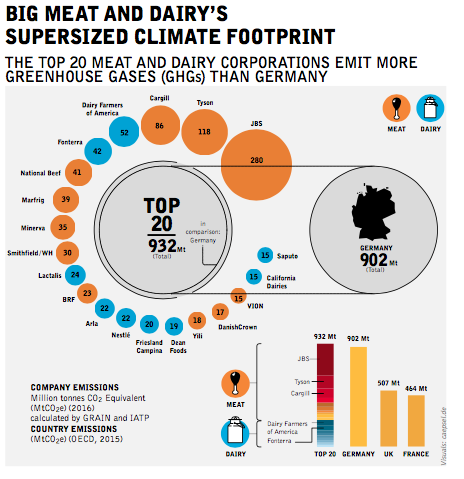
5) Reducing EU subsidies for food products with the 50% highest climate footprint.
The CAP, EU’s budget for farmers, is the most expensive EU subsidy programme and represents 40% of EU’s budget (53 billion euro a year). The EU is subsidizing farmers, for instance for beef and sheep production. Beef and sheep meat are products with the highest climate footprint per kg food, as can be seen at the picture below (cheese and milk have climate footprints per kg product, comparable with pork and chicken). Reducing subsidies for those products can help to reduce greenhouse gas emissions, and can be combined with campaigns for eating and drinking more plant based proteins. If the EU reduces subsidies to beef and sheep producers (2021-2027), less beef and sheep will be produced and consumed. This will reduce greenhouse gas emissions. The total of the EU interventions and direct subsidies to the livestock industry during 2007 is about three billion and a half euros. One in five biggest recipients of European farming subsidies are billionaires, by the way.
6) A global system for reducing greenhouse gas emissions from meat and dairy sectors (define an emission cap, with climate neutral growth in 2021-2025 and 1-2% reduction per year of emissions in 2025-2050.
The EU can take the lead to propose global agreements about CO2 eq. gaps for 2025, 2030 and 2050 for the meat and dairy sectors in the world (comparable with the aviation sector, but better and more effective). As meat and dairy consumption is growing worldwide, the greenhouse gasses related to them are growing too, but have to reduce considerably (as is agreed in the Paris Climate Agreement). So all meat and dairy sectors in all countries (and EU) can be asked or forced to work towards a net reduction of at least 1-2% of greenhouse gas emissions per year. Developed countries (G20) have higher goals for reduction of greenhouse gasses compared to developing countries: 2% per year versus 1% per year after 2025. This reduction of emissions, even when meat and dairy production and consumption is growing in a specific country, can be met by technical improvements (eg animal feed), sustainable energy production at farms (solar panels on roofs, windmills) or by compensation (paying for sustainable energy to be produced by others). Climate neutral meat and dairy will be a standard product in supermarkets in 2030, making dairy and meat only a few percent more expensive.
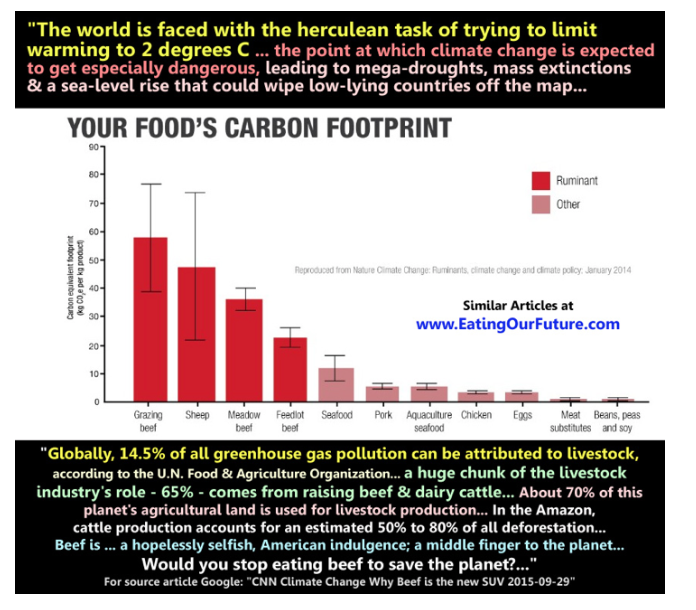
[1]https://www.eea.europa.eu/airs/2018/resource-efficiency-and-low-carbon-economy/food-consumption-animal-based
[2]https://www.ce.nl/publicaties/1273/milieueffecten-van-verbeteropties-voor-de-nederlandse-eiwitconsumptie
[3]https://www.cedelft.eu/publicatie/life_cycle_impacts_of_protein-rich_foods_for_the_superwijzer_app/1264
[4]http://www.meatless.nl/en/
[5]Hoe_werkt_emissiehandel_2017.pdf
[6]http://www.risefoundation.eu/images/files/2018/2018_RISE_LIVESTOCK_FULL.pdf
The True Animal Protein Price Coalition also welcomes the proposal for a European Food Policy developed by IPES in the beginning of 2019:
http://www.ipes-food.org/pages/CommonFoodPolicy
In the beginning of 2019 the International Panel of Experts on Sustainable Food Systems (IPES-Food) published research and a blueprint for a common food policy for the European Union. The IPES plan is based on 3 years of participatory research with over 400 farmers, businesses, NGOs, scientists and policymakers. It provides a vision to address climate change, halt biodiversity loss, improve diets and make farming viable for the next generation. Some of the recommendations are mentioned here, to promote sufficient, healthy and sustainable diets for all. Unhealthy diets are driving an obesity epidemic and an explosion of NCDs: the leading cause of death in Europe. Improving diets requires a range of policies to be realigned — from urban planning to food taxes andmarketing rules — to build food environments in which the healthy option is the easiest. Cheap calories can no longer be a substitute for social policies, which must be rebuilt and redesigned to tackle the root causes of poverty and promote access to healthy food for all. The EU must reform public procurement and VAT rules, and comprehensively restrict junk food marketing, in order to shift the incentives in favour of healthy and sustainable diets. Furthermore, the EU should require Member States to develop Healthy Diet Plans (covering public procurement, urban planning, fiscal and social policies, marketing, zoning & licensing and nutrition education) as a condition for unlocking CAP payments and exempt vegetables and fruits from VAT.
Other recommendations are related to new ways of decision making within the European political institutes:
Create a position of European Commission Vice President for Sustainable Food Systems
Designate a Head of Food in every Commission DG to ensure inter-sectoral cooperation
Develop a Sustainable Food Taskforce under the European Political Strategy Centre (EPSC)
Create a Formal Intergroup on Food in the European Parliament
Support creation of an EU Food Policy Council
Devise a Sustainable Food Scoreboard/Action Plan to track progress in the implementation of a Common Food Policy
